

Creative Diagnostics
Creative Diagnostics is a leading manufacturer and supplier of antibodies, viral antigens, innovative diagnostic components and critical assay reagents. We provide contract biologic R&D and manufacturing services to the diagnostic manufacturers along with GMP biologics manufacturing for the biopharmaceutical market.
Food Safety ELISA Kits. Immunoglobulin Antigens. Bacterial Antigens. Bacterial Background The Morphology and Fine Structure of Bacteria Bacterial cells are between 0.3 and 5 lm in size.

They have three basic forms: cocci, straight rods, and curved or spiral rods (Table 1). The nucleoid consists of a very thin, long, circular DNA molecular double strand that is not surrounded by a membrane. Among the nonessential genetic structures are the plasmids. Figure 1. Table 1. Cardiac Biomarkers Antigen. Introduction to Cardiac Marker Cardiac biomarkers are substances that are released into the blood when the heart is damaged or stressed.

Measurement of these biomarkers is used to help diagnose, risk stratify, monitor and manage people with suspected acute coronary syndrome (ACS) and cardiac ischemia. The symptoms of ACS and cardiac ischemia can vary greatly but frequently include chest pain, pressure, nausea, and/or shortness of breath. Fungal Antigens. Fungi Background General Characteristics of Fungi Fungi are microorganisms in the domain eukarya.
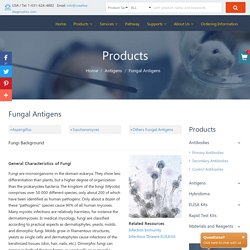
They show less differentiation than plants, but a higher degree of organization than the prokaryotes bacteria. Autoantigen. Introduction to Autoantigen Autoimmune diseases are the result of specific immune responses directed against structures of the self.
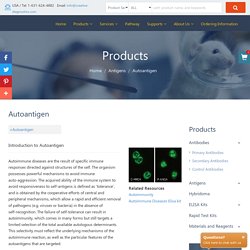
The organism possesses powerful mechanisms to avoid immune auto-aggression. The acquired ability of the immune system to avoid responsiveness to self-antigens is defined as ‘tolerance’, and is obtained by the cooperative efforts of central and peripheral mechanisms, which allow a rapid and efficient removal of pathogens (e.g. viruses or bacteria) in the absence of self-recognition. The failure of self-tolerance can result in autoimmunity, which comes in many forms but still targets a limited selection of the total available autologous determinants. This selectivity must reflect the underlying mechanisms of the autoimmune reaction, as well as the particular features of the autoantigens that are targeted. Table 1. Tolerance Breakdown. Parasitic Antigens. Parasites Background General Information on Parasites A parasite is defined as an organism that lives in a more or less close association with another organism of a different species (the host), derives sustenance from it and is pathogenic to the host, although this potential is not always expressed.
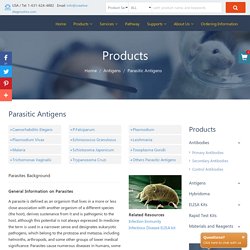
In medicine the term is used in a narrower sense and designates eukaryotic pathogens, which belong to the protozoa and metazoa, including helminths, arthropods, and some other groups of lower medical significance. Parasites cause numerous diseases in humans, some being of extraordinary significance. The parasites are categorized into two major groups: parasitic protozoa and parasitic helminths (Figure 1). Figure 1. Protozoa are unicellular eukaryotes that form an entire kingdom. Parasitic Antigens. Cytokines & Hormones Antigens. Introduction to Cytokines & Hormones Cytokines.
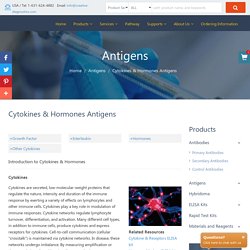
Hapten. About Hapten An antigen is any substance that may be specifically bound by an antibody molecule or T cell receptor.
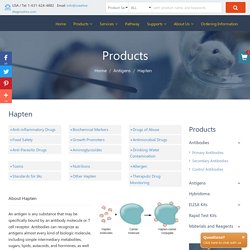
Antibodies can recognize as antigens almost every kind of biologic molecule, including simple intermediary metabolites, sugars, lipids, autacoids, and hormones, as well as macromolecules such as complex carbohydrates, phospholipids, nucleic acids, and proteins. This is in contrast to T cells, which mainly recognize peptides. Although all antigens are recognized by specific lymphocytes or by antibodies, only some antigens are capable of activating lymphocytes. Molecules that stimulate immune responses are called immunogens. Figure 1. The term hapten (half antigen) was introduced in the 1920s by Karl Landsteiner to define low molecular weight chemical reagents which, as such, will not induce immune responses. Drugs & Chemicals ELISA Kits. About Drugs and Chemicals ELISA is a powerful immunoassay that can qualitatively or quantitatively detect the chemicals, drug residual and other microbial toxins.
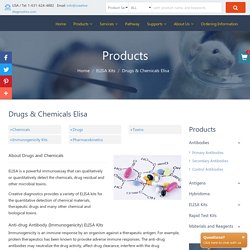
Creative diagnostics provides a variety of ELISA kits for the quantitative detection of chemical materials, therapeutic drugs and many other chemical and biological toxins. Anti-drug Antibody (Immunogenicity) ELISA Kits Immunogenicity is an immune response by an organism against a therapeutic antigen. For example, protein therapeutics has been known to provoke adverse immune responses. Because of the severity of these unwanted side effects, mandatory provision has been made by U.S. Hormone Markers ELISA Kits. Hormone Background.
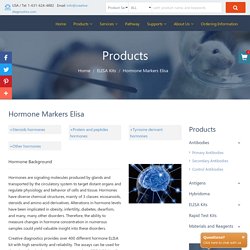
Phosphorylation ELISA Kits. Cytokines and cytokine receptors ELISA Kits. Introduction of Cytokine & Receptors Cytokines are low-molecular weight regulatory proteins or glycoproteins secreted by immune cells (monocyte, macrophage, T lymphocyte, B lymphocyte, Nature killing cells etc.) and various other cells (endotheliocyte, epithelial cells, fibroblast etc.) in the body in response to a number of stimuli.
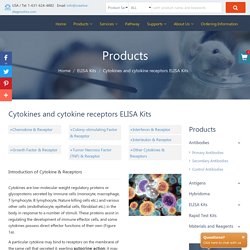
These proteins assist in regulating the development of immune effector cells, and some cytokines possess direct effector functions of their own (Figure 1a). A particular cytokine may bind to receptors on the membrane of the same cell that secreted it, exerting autocrine action; it may bind to receptors on a target cell in close proximity to the producer cell, exerting paracrine action; in a few cases, it may bind to target cells in distant parts of the body, exerting endocrine action (Figure 1b). Immunology. Overview of Immunology Immunology is a bio medical science that studies the immune response of an organism against the original substance and its methods. Immune response is not only the response of the organism to antigen stimulation, but also a biological process of recognizing and eliminating antigen substances.
Many components of the immune system are typically cellular in nature and not associated with any specific organ; but rather they are embedded or circulated in various tissues located throughout the body. Gastrointestinal Disease ELISA Kits. Tumor Marker ELISA Kits. Tumor Marker Background Cancer (malignant tumors) is a major health problem worldwide and one of the most important causes of morbidity and mortality in children and adults.
The existence of specific anti-tumor immunity implies that tumors must express antigens that are recognized as foreign by the host. Tumor markers are defined as biological molecules (proteins, peptides etc.) indicating the existence of tumors inside the organism. Cardiac Marker ELISA kit. Cardiac Disease Background Cardiovascular disease is a class of diseases that involve the heart or blood vessels. it has remained the leading cause of death worldwide despite the tremendous progress made in medical and surgical treatment for this disease. Overview of Autoimmunity. Introduction The immune system has very powerful effector mechanisms that can eliminate a wide variety of pathogens.
Early in the study of immunity, it was realized that these could, if turned against the host, cause severe tissue damage. Digestive System Development. Digestive system development overview The digestive system consists of two parts: the digestive tract and the digestive gland. The digestive tract is a long, muscular duct from the mouth that continues the pharynx, esophagus, stomach, small intestine, large intestine, and anus. The organs that pass through include the mouth, pharynx, esophagus, stomach, small intestine (duodenum, jejunum, ileum) and the large intestine (cecum, colon, rectum). The digestive gland has two small digestive glands and one large digestive gland.
The small digestive glands are scattered in the wall of each part of the digestive tract. Excretory System Development. Gametes and Fertilization. Gametes and fertilization overview Sexual reproduction refers to the sexual germ cells (gametes) produced by the parents, through the combination of bisexual germ cells (such as sperm and egg cells), become the fertilized egg, and then the fertilized egg develops into a new individual, called sexuality reproduction. Extensive variation in gene combinations in sexual reproduction can increase the ability of offspring to adapt to natural selection.
Randomly combined genes in offspring of sexual reproduction may or may not be beneficial to the species, but at least increase the chances of a few individuals surviving in an unpredictable and ever-changing environment, thereby benefiting the species. Gastrulation and Germ Layer Formation. Immune System Development. Functional Gold Nanorods. NanoCubes. Creative Diagnostics Nanocubes (NCs) are surface plasmon resonant (SPR) cubic shaped gold particles along with SERS (Surface-enhanced Raman spectroscopy). These NCs are produced in different size from 30 nm to 100 nm, with absorption max ranges from 523 nm to 569 nm.
Protein G Magnetic Particles. Fluorescent Gold Nanoparticles. Creative Diagnostics provides Fluorescent Gold Nanoparticles (AuNPs) labeled with various fluorophores for multimodal imaging by dark-field scattering, fluorescence, as well as electron microscopy. The fluorophore labeled gold nanoparticles exhibit both high absorptions and scattering from gold nanoparticle as well as enhanced fluorescence from the attached fluorophores. Fluorescent Gold Nanoparticles. Basic Magnetic Particles. Creative Diagnostics offers unmodified magnetic particles to meet our customers’multiple needs. NanoCubes. Functional Quantum Dots. Gold Nanoparticles Conjugation Kits. Silica Magnetic Particles. Genotoxic Stress Response. Cancer Stem Cells. Cancer Epigenetics. Cancer Biomarkers. Cancer and Apoptosis. Angiogenesis and Cancer.
Cancer and Autophagy. Cancer. Functional Gold Nanorods. CsPbX3 Perovskite Nanocrystals. Protein-Based Fluorescent Nanoparticles. Lanthanide-Based Magnetic Particles. Functional Quantum Dots. Gold Nanoparticles Conjugation Kits. Silica Magnetic Particles. Fluorescent Silica Particles. Time-resolved Fluorescent Microspheres. Fluorescent Silica Particles.
Special Shape Particles. Streptavidin Magnetic Particles. Gold Coated Magnetic Nanoparticles. MagIso™ Ti Magnetic Phosphopeptide Enrichment Kit. General Nanotoxicity Mechanism. Nanoparticles Analytical Techniques. Mycotoxins analysis. Food pathogens analysis. Pesticides analysis. Ochratoxin analysis. Aflatoxin analysis. Food & Feed Analysis. Pharmacosomes Production - CD Bioparticles. Immunoliposomes (Ligand-Targeted Liposomes) Production - CD Bioparticles. Immunoassay. Chemiluminescence Immunoassay Guide. Small Iron Oxide Nanoparticles. Self-Assembled Monolayers Reagents. NanoHollows. NanoClusters. NanoChains. NanoShuttles. NanoPlates. NanoBipyramids. Chk Signaling Pathway. CDK Signaling Pathway. Relaxin Signaling Pathway. Oxytocin Signaling Pathway. Prolactin Signaling Pathway.
Thyroid Hormone Signaling Pathway. PPAR Signaling Pathway. Estrogen Signaling Pathway. Insulin Signaling Pathway. MELK Signaling Pathway. Neurotrophin Signaling Pathway. PPAR Signaling Pathway. Thyroid Hormone Signaling Pathway. Prolactin Signaling Pathway. Oxytocin Signaling Pathway. Oxytocin Signaling Pathway. Relaxin Signaling Pathway. Small Iron Oxide Nanoparticles. Self-Assembled Monolayers Reagents. NanoHollows. NanoClusters. NanoChains. NanoShuttles. NanoPlates.